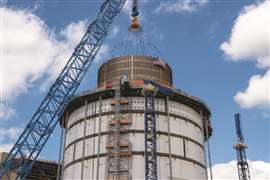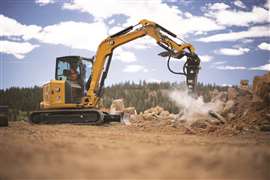US construction: A market that defies expectations
16 July 2024
US construction equipment sales were expected to drop in 2023 but instead set a record. Can the country shatter expectations again in 2024? Mitchell Keller reports

Less than one year ago – in the September/October 2023 edition of International Construction – North American equipment sales (for which the US accounts for more than 90%) for 2022 were reported at a record-high with 2023 figures expected to drop slightly.
Just a few months later, it turns out that the downturn experts were expecting never materialised. Instead, another record was set with more than 330,000 construction units sold; an 8% increase from the year-prior and another sales record for the region.
The high sales levels are a symptom of the fact that construction activities – especially on infrastructure – have received a bevy of federal funding, and the industry is expected to remain busy through 2026.
While analysts are sceptical the country can break the equipment sales record three straight years, with megaprojects on the rise, more advanced machines will be needed than ever before, as the industry (machine sales aside) is poised again for another strong year of construction revenues.
Labour shortage issues
Perhaps what’s most intriguing about the US’ construction industry success in 2023 is that it made significant gains where its peers saw declines.
“For example, equipment sales in Canada dropped around 5% in 2023, and the European market was down by a similar amount,” says Chris Sleight, managing director of Off-Highway Research.
Sleight believes 2024 will see a decrease but noted that even as much as a 10% decline would still put equipment sales near a long term historic high. A drop, also, could help quell concerns about bloating inventory figures in the rental segment.
Off-Highway Research anticipates North American equipment sales will again top the 300,000-units sold mark, which would be the first time in history the continent moved that many units in three consecutive years.
“This should all help keep the construction equipment market at very good levels in 2024,” said Sleight. “Unit sales might be lower because the slowdown in residential will affect demand for high-volume compact equipment.

“However, the pivot toward infrastructure and larger-scale non-residential building means fewer, larger machines, which is helpful for both the value of the sector and the margins of those who sell them.”
Anirban Basu, chief economist for the US-based Association of Builders and Contractors (ABC), expressed surprise regarding 2023’s successes.
“I was far too pessimistic last year,” he said during a first quarter industry forecast webinar. “I thought 2023 was going to be a difficult year for the United States, and it turned out not to be in many ways.”
The construction industry was also aided by high consumer spending across the board, which prevented the country from entering a long-anticipated recession. Immense federal expenditure from the Infrastructure Investment and Jobs Act (IIJA), the Inflation Reduction Act (IRA), and Creating Helpful Incentives to Produce Semiconductors (CHIPS) Act also helped stave off an economic downturn and pumped money directly into construction projects.
It wasn’t all without headwinds, though. The industry’s dark cloud – a skilled labour shortage – remained throughout the year and, in some cases, worsened. That reality has prevented outlooks for 2024 from being too optimistic.
But, while some regions struggled with construction employment figures, there were other regions where worker shortages eased.
The biggest gains (from 6.5% up to 10.7%) in construction job growth over the last four years came in Texas and Florida among the US’ major metros. California saw the largest decrease in construction employment rate, while the metros of Baltimore, Boston, and Portland, Oregon, also experienced large dips.
Ken Simonson, chief economist for the Associated General Contractors of America (AGC), says, “I do think that the number one concern of most contractors, whether infrastructure or otherwise, is finding enough labour to execute the projects.
“While not every state had an increase in employment, more of them would have if there had been enough workers available.”
Manufacturing and infrastructure megaprojects
If the US is to again beat expectations, it is likely to come from tailwinds in manufacturing and infrastructure megaprojects.
Sleight compared the manufacturing-facility construction segment from 2017-2021 with the post-2022 value to illustrate the growth in the sector.
“The CHIPS Act provided remarkable impetus for the construction of manufacturing facilities. In 2017-2021, this market was worth US$66 to $78 billion per year, according to U.S. Census Bureau data. However, in 2022, it shot up to $106 billion and the final total for 2023 is likely to be in the $150 to $180 billion range,” he says.
 A crew places a cap on a nuclear reactor build in Georgia, US. Bechtel served as contractor for the Plant Vogtle project (Photo: Bechtel)
A crew places a cap on a nuclear reactor build in Georgia, US. Bechtel served as contractor for the Plant Vogtle project (Photo: Bechtel)
The IRA, too, helped facilitate one of the country’s largest ever infrastructure investments. The total value of the segment moved up just 4% in 2022 ($374 billion), but the figure for 2023 is more than $400 billion, driven largely by highway and road builds.
ABC’s data suggests there was a nearly 190% increase in manufacturing build spending from February 2020 to January 2024. Basu says there are so many projects that haven’t even started construction in the sector that he expects activity to remain elevated for ‘years to come’. Megaprojects for Intel in Ohio, a Micron facility in New York, and a Samsung project in Texas, Basu says, are just three examples of major manufacturing builds stimulated by US federal government investment.
The staggering growth in manufacturing construction is also absent data centre figures, which ABC logged in its ‘Office’ subsector.
At just 4.7% growth from 2020 to the present in the office subsector, and with office vacancies above a ten-year high in the country, Basu notes that data centre builds are carrying the subsection. According to data from Global Information, the current US data centre construction market is valued at $25 billion and expected to reach $33 billion by 2029.
AGC’s Simonson notes a similar observation for utility works. “Excuse the pun, [but] It does look as if the money for water and sewer projects started flowing,” he says.
But not all segments obtain funding through the same mechanisms, and Simonson points to a larger pot of cash – for the highways and bridges – as having stricter requirements to obtain. Getting approval for and acquiring some imported materials, like steel, are tightly regulated.
“[The IIJA] requires a lot more steps or hoops to jump through, and I think that’s really delayed the disbursement of the money and the actual work on projects much longer than most people expected,” Simonson says, noting a “Buy American” initiative has added additional steps to a waiver process for imported materials.
“The Biden administration has really tightened up on those waivers and took them a long time even to say what the process would be,” he continues. “In general, this will delay or add to the cost of the entire project, not just the material [purchased].”
Grading American infrastructure
Every four years, the American Society of Civil Engineers (ASCE) provides a letter grade for the country’s infrastructure across 17 different categories (like bridges, roads, utilities, etc.).
Next year, the organisation will release a report card since its last update in 2021. The US scored a slightly below average “C-” that year, with transit (D-), dams (D), and stormwater infrastructure (D) scoring the lowest. The highest marks were given to rail (B) and ports (B-)
“We use eight different criteria to identify those grades,” explains Kristina Swallow, chair of the ASCE’s Committee on America’s Infrastructure.
 The Caterpillar 305 CR Mini Excavator. The US-based OEM’s sales hit a record of US$67.1 billion in 2023, up 13% on 2022 (Photo: Caterpillar)
The Caterpillar 305 CR Mini Excavator. The US-based OEM’s sales hit a record of US$67.1 billion in 2023, up 13% on 2022 (Photo: Caterpillar)
For next year’s grading, Swallow says the committee is considering an important question on top of its regular scoring rubric: Is the country funding at the level needed to achieve the quality of infrastructure needed as a nation?
She says it’s still too early to guess where grades might end up but noted immense change to the infrastructure construction segment since the last report card.
“The federal government approved the IIJA and really significantly increased the federal share of investment in infrastructure,” she says.
It’s spurred some optimism that the US could improve on its C-, and even ACSE’s recently released economic study, titled Bridging the Gap alludes in name to higher expectations for the country. Their 2021 economic study, by comparison, was titled Failure to Act.
Swallow says the ripple effects of infrastructure investment will be positive, but the question remains for how long. Funding for the major infrastructure packages is meant to run through 2026, leaving doubts as to what happens after.
“The analysis stretches across 20 years (2024 – 2043) and includes two scenarios,” states the report. “One scenario assumes that this new level of infrastructure funding represents the baseline for future funding levels – this is called the ‘Continuing to Act’ scenario. The other scenario assumes that, after 2026, infrastructure investment reverts to funding levels from before 2022 – this scenario is called ‘Snapback’.
Still, the immediate and short-term effects, Swallow believes, have been fruitful, and despite it being an election year for the US, she thinks the need to improve infrastructure nationwide is a non-partisan issue.
“There’s a lot of polling data that shows both sides [Democrats and Republicans] really understand how critically important it is to fund infrastructure,” she says. “We’re fortunate that the stars and planets aligned such that we did get this IIJA bill through, and we are now seeing the benefits of that. That said, we will need to continue to invest in our infrastructure.”
 Aerial panorama of a tower crane on-site in Miami, Florida, US (Photo: AdobeStock)
Aerial panorama of a tower crane on-site in Miami, Florida, US (Photo: AdobeStock)
Will a recession hamper US construction momentum?
A flurry of infrastructure and construction activity has not necessarily led to an increase in available workers: the skilled labour shortage remains an overwhelming hinderance to the US market.
Between 2019 and 2020, the US construction industry unemployment rate hovered around 3% according to data from the US Bureau of Labor Statistics. As of February 2024, that figure rests above a 10-year high of 5%.
A labour shortage, coupled with rising consumer credit card debt and high interest rates, could weaken what’s been a resilient region for construction growth. Even with funding and projects lined up, it’s possible the extremely tight labour market could cause days and lost profit.
ABC’s Basu says there were approximately 413,000 construction openings at the beginning of the year, which has ballooned from a pre-pandemic figure closer to 300,000 and adds that contractors were complaining about the lack of skilled workers even before the pandemic.
Sleight agrees that it’s doubtful 2024 will be the big surprise that 2023 was. “It is unlikely that such steep rates of growth will continue,” he says. “Construction backlogs are finally starting to fall, and the various confidence indicators and measures of expectations are pointing more clearly toward small increases in work and staffing levels.”
Still, US construction activity is categorically high – and higher than other countries. “Even with a cooling in the market, the amount of construction activity in North America will remain at historically high levels,” said Sleight. “A positive of this is that inflation in materials prices and labour costs should moderate.”





